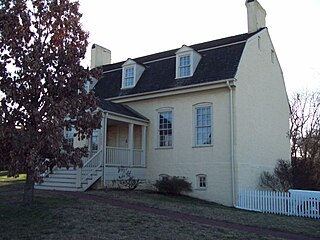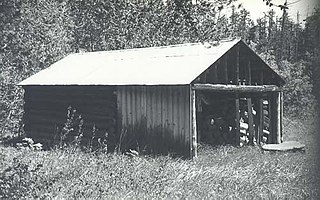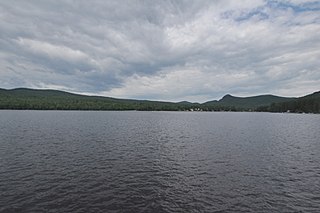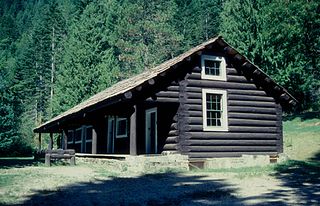
The Selway River is a large tributary of the Middle Fork of the Clearwater River in the U.S. state of Idaho. It flows within the Selway-Bitterroot Wilderness, the Bitterroot National Forest, and the Nez Perce National Forest of North Central Idaho. The entire length of the Selway was included by the United States Congress in 1968 as part of the National Wild and Scenic Rivers Act.

The Jenny Lake Ranger Station Historic District comprises an area that was the main point of visitor contact in Grand Teton National Park from the 1930s to 1960. Located near Jenny Lake, the buildings are a mixture of purpose-built structures and existing buildings that were adapted for use by the National Park Service. The ranger station was built as a cabin by Lee Mangus north of Moose, Wyoming about 1925 and was moved and rebuilt around 1930 for Park Service use. A store was built by a concessioner, and comfort stations were built to Park Service standard plans. All buildings were planned to the prevailing National Park Service Rustic style, although the ranger station and the photo shop were built from parts of buildings located elsewhere in the park.

The William Hilleary House, or Hilleary-Magruder House, is a historic home located at Bladensburg in Prince George's County, Maryland, United States. The house is the only 18th-century stone, gambrel-roofed house in Prince George's County. It is now surrounded to the south and west by an exit ramp connecting Kenilworth Avenue with Annapolis Road.

The Lee Creek Snowshoe Cabin was built in Glacier National Park in 1925–27 by Austin Swikert as a shelter for winter hikers. The log structure consists of a single room with wood floor, unfinished walls and roof. A trap door in the floor provides access to a small cellar food cache. There is a woodstove with metal chimney.

The historical buildings and structures of Zion National Park represent a variety of buildings, interpretive structures, signs and infrastructure associated with the National Park Service's operations in Zion National Park, Utah. Structures vary in size and scale from the Zion Lodge to road culverts and curbs, nearly all of which were designed using native materials and regional construction techniques in an adapted version of the National Park Service Rustic style. A number of the larger structures were designed by Gilbert Stanley Underwood, while many of the smaller structures were designed or coordinated with the National Park Service Branch of Plans and Designs. The bulk of the historic structures date to the 1920s and 1930s. Most of the structures of the 1930s were built using Civilian Conservation Corps labor.

The Graves Creek Ranger Station is a small historic district in Olympic National Park, Washington, USA. It includes the first administrative buildings to be built by the National Park Service in the newly designated park. The district comprises two buildings built in 1939-41 by the National Park Service in the Graves Creek region of the western park. Labor from the Civilian Conservation Corps and the Public Works Administration was used for both the ranger station residence and the garage-woodshed, as well as for a generator building that no longer stands. The 1939 ranger station residence is a one-story frame structure, clad in cedar shingles. The garage is of similar construction, built in 1941. Both structures are examples of the late National Park Service Rustic style, featuring broad shingle courses and deep eaves.
Architects of the United States Forest Service are credited with the design of many buildings and other structures in National Forests. Some of these are listed on the National Register of Historic Places due to the significance of their architecture. A number of these architectural works are attributed to architectural groups within the Forest Service rather than to any individual architect. Architecture groups or sections were formed within engineering divisions of many of the regional offices of the Forest Service and developed regional styles.
The Butte Falls Ranger Station, located in Rogue River – Siskiyou National Forest in Butte Falls, Oregon, was built in 1935 by the Civilian Conservation Corps. It was designed by architects of the United States Forest Service in rustic style.

The Beaver Creek Ranger Station near Rimrock, Arizona was built in 1935 by the Civilian Conservation Corps. It was designed by architects of the U.S. Forest Service. It was listed on the National Register of Historic Places on June 10, 1993, for its architecture, which is of Bungalow/Craftsman style. It served historically as institutional housing and as government office space. The NRHP listing was for three contributing buildings and two other contributing structures on a 47-acre (19 ha) area.
The Atlanta Ranger Station, also known as Atlanta Guard Station, is a 24 acres (9.7 ha) historic district in Boise National Forest in Atlanta, Idaho that was listed on the National Register of Historic Places in 2003. It includes 10 contributing buildings dating as far back as 1933. The complex was built by the Civilian Conservation Corps and designed by the USDA Forest Service, and includes Forest Service R-4 Standard and other architecture. The listing included ten contributing buildings.

The Council Ranger Station located in Council, Idaho, listed on the National Register of Historic Places.

Fenn Ranger Station is a U.S. Forest Service ranger station in the Nez Perce National Forest near Kooskia, Idaho. The ranger station serves as the headquarters of the Moose Creek Ranger District, which encompasses 870,000 acres (350,000 ha) of the forest. The Civilian Conservation Corps began building the ranger station in 1936 and finished the main administration building as well as two garages and two warehouses in 1937. Various other structures were added to the site in the next three years, with the last building, a barn, completed in 1940. The ranger station was added to the National Register of Historic Places on June 18, 1990.

The College Creek Ranger Station, near Imnaha, Oregon outside of Enterprise, Oregon, was built in 1935. It is located along the Imnaha River in the Wallowa–Whitman National Forest. It includes rustic architecture of USDA. It was listed on the National Register of Historic Places in 1991; the listing includes four contributing buildings.

Stillwater State Park is a state park located on Lake Groton in Groton, Vermont. The park is located in Groton State Forest close to the Groton Nature Center, Boulder Beach State Park and Big Deer State Park. The park offers camping, picnicking, and access to water-related activities on Lake Groton. The park was developed in the 1930s by crews of the Civilian Conservation Corps (CCC). It is open to the public between Memorial Day weekend and Columbus Day weekend; fees are charged for day use and camping.
The Jack Creek Guard Station is a ranger patrol cabin in Medicine Bow National Forest in Carbon County, Wyoming. The one-room log cabin was built by U.S. Forest Service district ranger Evan John Williams in 1933-34. It was built to Forest Service Plan A-4, featuring half-dovetailed corners and a deep front porch with a gabled wood shake roof. A stove is vented through a brick chimney at the back of the cabin.

The Lochsa Historical Ranger Station, also known as Lochsa Ranger Station, near Kooskia, Idaho in Idaho County, Idaho, was built during 1927 to 1933. It served as administrative headquarters for the Lochsa Ranger District from 1922 to 1957. It was located within the Selway National Forest which was later merged into the Clearwater National Forest and the Nezperce National Forest. It was listed on the National Register of Historic Places in 1978.
The Chamberlain Ranger Station Historic District, also known as the Chamberlain Guard Station, is located in the Frank Church-River of No Return Wilderness within Payette National Forest in Idaho County, Idaho. It was listed on the National Register of Historic Places in 2004.

A ranger station is a building complex typically including a dwelling and outbuildings which support a ranger or other guardian of a wilderness or national forest area.

The Edward and Ida Soncarty Barn, at 1671 Deep Creek Rd. in Potlatch, Idaho, is a Gothic-arch barn built in 1928. It was listed on the National Register of Historic Places in 2008.
Dry Creek Rockshelter near Boise, Idaho, is an archaeological site showing periodic use over approximately 3000 years. The site is located under a sandstone overhang, roughly 21 metres (69 ft) wide by 4 metres (13 ft) deep. The rockshelter is unique in that no other local sandstone outcrops are large enough for human habitation. The site was added to the National Register of Historic Places in 1991, and the site address is listed as restricted.
















